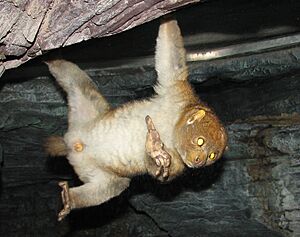Bosman's potto facts for kids
Quick facts for kids West African potto |
|
|---|---|
 |
|
| Conservation status | |
| Scientific classification | |
| Genus: |
Perodicticus
|
| Species: |
potto
|
| Synonyms | |
|
|
The West African potto (Perodicticus potto) is a small, furry animal. It is a type of primate, like monkeys and apes. This animal is active at night, which means it is nocturnal. You can find it living in the warm, wet forests of West Africa. People sometimes call it Bosman's potto. This name comes from Willem Bosman, who first wrote about this animal in 1704.
Contents
What is the West African Potto?
The West African potto is a fascinating creature. It is part of a group of animals called strepsirrhine primates. This group includes lemurs and lorises. Pottos are known for their slow, careful movements. They spend most of their lives in trees.
How Many Potto Species Are There?
For a long time, scientists thought there was only one type of potto. This was the Perodicticus potto. But in 2015, a new study changed this idea. Scientists found that there are actually three different potto species. The name Perodicticus potto now only refers to the West African potto. The other two species live in different parts of Africa.
The Mystery of the False Potto
There was once a mysterious animal called the "false potto". Scientists thought it was a completely different species. However, it is now believed that the false potto was actually a West African potto. It was simply misidentified by scientists.
Where Do West African Pottos Live?
The West African potto lives in a specific part of Africa. Its home stretches from Guinea in the west to Nigeria in the east. There is also a separate group of pottos in eastern Senegal. This means their population is split up. The Niger River acts as a natural border. It separates the West African potto from another species, the Central African potto.
What Are the Threats to Pottos?
West African pottos face several dangers. Even though they can live near people, their homes are shrinking. This is because the human population is growing. More people means more habitat destruction.
Why Are Forests Disappearing?
Many forests are being cut down. This is often for industrial agriculture. Large farms need a lot of land. This loss of forest means pottos have fewer places to live. It also means their numbers are going down quickly.
Why Are Pottos Hunted?
Pottos are also hunted for food. This is called bushmeat. People used to hunt larger animals. But these larger animals are now harder to find. So, hunters are turning to smaller animals like pottos. This makes pottos even rarer in the wild.
How Are Pottos Protected?
Because of these threats, the West African potto is listed as "Near Threatened". This status is given by the IUCN Red List. It means the species could become endangered soon if things do not change. Efforts are being made to protect their forests and reduce hunting.


